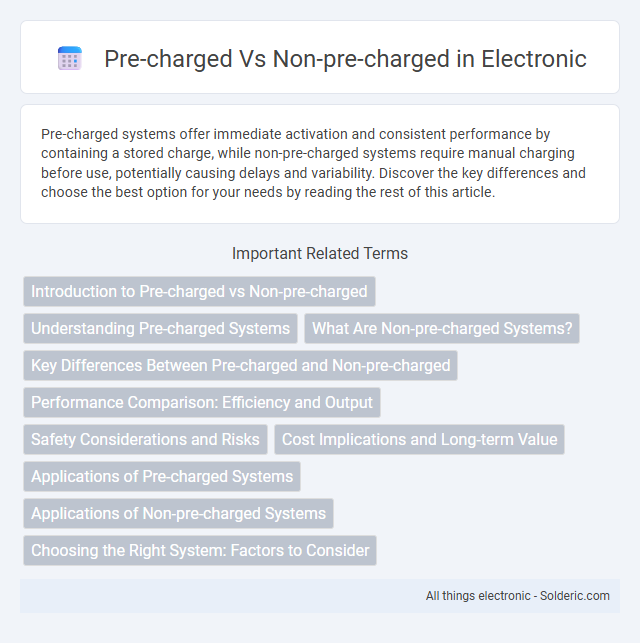Pre-charged systems offer immediate activation and consistent performance by containing a stored charge, while non-pre-charged systems require manual charging before use, potentially causing delays and variability. Discover the key differences and choose the best option for your needs by reading the rest of this article.
Comparison Table
| Feature | Pre-charged Batteries | Non-pre-charged Batteries |
|---|---|---|
| Definition | Batteries pre-charged at the factory, ready to use | Batteries shipped without charge, require initial charging |
| Usage | Immediate use after purchase | Requires charging before first use |
| Shelf Life | Shorter shelf life due to slow discharge | Longer shelf life when stored properly |
| Convenience | High convenience for quick deployment | Less convenient, delay due to initial charging |
| Applications | Consumer electronics, emergency devices | Industrial tools, backup power systems |
| Cost | Usually higher due to added manufacturing step | Typically lower cost initially |
Introduction to Pre-charged vs Non-pre-charged
Pre-charged systems come pre-filled with air or gas to provide immediate functionality, enhancing convenience and reducing setup time. Non-pre-charged systems require manual inflation before use, offering customizable pressure settings but demanding additional preparation. Understanding the operational differences between pre-charged and non-pre-charged options is essential for selecting the appropriate system based on application needs and maintenance preferences.
Understanding Pre-charged Systems
Pre-charged systems come with an internal charge of inert gas, usually nitrogen, which maintains consistent pressure and reduces the risk of air infiltration or contamination. You benefit from easier installation and lower maintenance compared to non-pre-charged systems that require manual filling and regular pressure adjustments. Understanding the distinct pressure management and reliability advantages of pre-charged systems helps optimize system performance and longevity.
What Are Non-pre-charged Systems?
Non-pre-charged systems, commonly found in HVAC and hydraulic applications, utilize an expansion tank without a pre-filled inert gas like nitrogen, relying solely on the system's liquid to maintain pressure. These systems require careful monitoring of fluid levels and pressures to prevent issues such as waterlogging or corrosion, impacting overall performance and longevity. Understanding your system's type ensures proper maintenance and avoids costly failures.
Key Differences Between Pre-charged and Non-pre-charged
Pre-charged air guns come with compressed air stored in the cylinder ready for immediate use, offering consistent power and increased accuracy compared to non-pre-charged models that require manual pumping or external charging before firing. Pre-charged systems generally provide a higher shot count per fill and smoother shooting experience, while non-pre-charged air guns are simpler, lighter, and often more affordable due to the absence of built-in air reservoirs. Understanding these key differences helps you choose the most suitable air gun based on your shooting preferences and maintenance capabilities.
Performance Comparison: Efficiency and Output
Pre-charged batteries deliver superior efficiency by providing instant high power output without requiring initial charging time, making them ideal for devices demanding consistent performance. Non-pre-charged batteries may offer longer shelf life but often suffer from voltage drops and reduced efficiency during high-drain usage, impacting overall device output. Understanding your device's power needs ensures that you select the battery type optimizing both runtime and energy efficiency.
Safety Considerations and Risks
Pre-charged systems minimize the risk of over-pressurization and potential explosion by eliminating the need for on-site pressurization, ensuring safer handling and installation. Non-pre-charged systems require manual air charging, which can introduce contamination or incorrect pressure levels, increasing the risk of system failure and potential water damage. Proper maintenance and adherence to manufacturer guidelines are critical for both types to prevent hazardous scenarios and ensure operational safety.
Cost Implications and Long-term Value
Pre-charged batteries typically have higher upfront costs but offer better long-term value due to enhanced efficiency and reduced replacement frequency. Non-pre-charged batteries may save money initially but often require more frequent replacements, increasing overall expenditure over time. Your investment in pre-charged options can lead to cost savings and improved performance throughout the product's lifespan.
Applications of Pre-charged Systems
Pre-charged systems are widely used in residential, commercial, and industrial water filtration applications due to their convenience and ease of installation. These systems come with media already loaded and pressurized, reducing downtime and maintenance efforts compared to non-pre-charged units, which require manual filling and setup. You benefit from reliable performance in applications such as drinking water purification, reverse osmosis pre-filtration, and softening where consistent filtration quality is critical.
Applications of Non-pre-charged Systems
Non-pre-charged systems are commonly utilized in large-scale water distribution networks and industrial fluid control where flexibility in pressure adjustment is essential. Their capability to allow customization of initial air charge makes them ideal for applications with varying load conditions, such as irrigation systems and municipal water supply. These systems offer cost-effective solutions for managing pressure fluctuations without the need for frequent pre-charging maintenance.
Choosing the Right System: Factors to Consider
Choosing the right system between pre-charged and non-pre-charged depends on factors such as installation complexity, maintenance frequency, and application requirements. Pre-charged systems offer easier installation and lower maintenance due to their sealed design, while non-pre-charged systems provide flexibility for customization and can be more cost-effective for large-scale operations. Assess your specific needs, including system size, reliability expectations, and budget constraints to determine which option aligns best with your operational goals.
Pre-charged vs Non-pre-charged Infographic

 solderic.com
solderic.com